More than 300,000 marchers flooded the streets of New York on Sunday in the largest climate change march in history, vaulting the environmental threat to the top of the global agenda.
On a day of 2,700 simultaneous climate events from Melbourne to Manhattan, the US secretary of state, John Kerry, reinforced the calls from the streets for action by calling on world leaders to take the threat of climate change as seriously as Isis or Ebola.
Organisers had called the day of protests in order to put pressure on world leaders gathering in New York for a UN summit on climate change on Tuesday. It will be the leaders’ first such meeting in five years.
Kerry, in remarks to foreign ministers of the 20 biggest economies, said climate change should be at the top of the agenda despite competition from more immediate challenges.
“While we are confronting [Isis], and we are confronting terrorism and we are confronting Ebola, this also has an immediacy that people have come to understand,” he said. “There is a long list of important issues before all of us, but the grave threat that climate change poses warrants a prominent position on that list.”
Organisers claimed 570,000 people protested in 161 countries, from a handful of protesters in Aleppo, Syria, to the mega-march by 310,000 through New York City – three times as many as the 100,000 people organisers had expected, and easily overtaking the 80,000 who demonstrated for climate action in Copenhagen in 2009.
In Manhattan, the noisy, hopeful cavalcade of protesters – led by Hurricane Sandy survivors carrying placards of sunflowers and Native Americans in traditional headdresses – took over the streets of Midtown, juggling, singing, blowing synagogue shofars and conch shells, whistling and beating drums, with biodiesel-powered floats chugging along.
They hoisted a papier-mache representation of Mother Earth and a giant parachute emblazoned with monarch butterflies, and carried signs reading “Melt chocolate, not polar ice caps” and “May the forest be with you”.
Leonardo di Caprio marched with Mark Ruffalo; the UN secretary general, Ban Ki-moon, marched with the former US vice-president Al Gore. At least three Democratic members of the Senate also joined.
“People are now much more aware in all our countries of how important this topic is,” said the French foreign minister, Laurent Fabius, who joined the march in Manhattan.
Upper West Side mothers pushed expensive strollers alongside protesters carrying signs reading “angry pacifists”.
“I think it will make a difference,” said Tashina Red Hawk, aged 10, who wore intricately beaded traditional Sioux Indian dress, and who lives on the Rosebud reservation in South Dakota. “But it would still be good to do all kinds of other stuff.”
She went on: “If you don’t take care of the land, it won’t take care of you.”
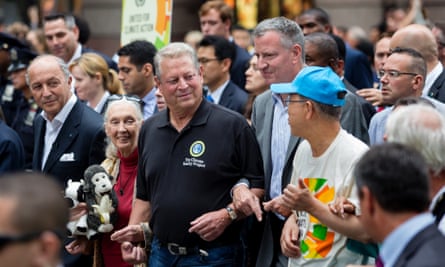
In London, organisers said 40,000 took to the sunlit streets and marched to the Houses of Parliament. The protest was peaceful, although loud jeers rose up as the crowd passed both Downing Street and the Department of Energy and Climate Change.
In Melbourne, protesters paraded a giant puppet of the Australian prime minister, Tony Abbott.
The People’s Climate March came two days before the US president, Barack Obama, and about 120 other world leaders gather for the UN meeting on climate change.
The challenge for those leaders is clear: left unchecked, the world is on course for a 4.5C temperature rise. “For us that means annihilation,” said Tony deBrum, the foreign minister of the Marshall Islands.
Annual carbon dioxide emissions rose 2.5% over last year, a new study found at the weekend. At those rates, that means the global “carbon budget” – the amount governments can afford to emit without triggering catastrophic change – is likely to be used up within just 30 years.
The US National Oceanic and Atmospheric Administration announced last week that June, July, and August were the hottest months on record and that 2014 was on course to break the record for hottest year, which was set in 2010.
But the agenda for Tuesday’s gathering is uncertain. The UN has said repeatedly the gathering is not a negotiation. That will take place in Lima in two months’ time, when diplomats will enter the final stretch of long and difficult negotiations aimed at reaching an international agreement to cut the greenhouse gases that cause climate change, by the time they meet in late 2015 in Paris.
The UN said it will use Tuesday’s gathering to press world leaders to do more: to cut more carbon and, for the rich countries, put up more cash to help poor countries cope with climate change.
DeBrum said countries such as his, on the frontline of climate change, needed to see concrete signs that leaders were prepared to make deep cuts in greenhouse gas emissions and put up the cash needed to help poor countries cope with climate change. He said he was disappointed that leaders of some of the biggest polluters – China, India, Canada, and Australia – would not be at the climate summit.
Those at Sunday’s protests said their show of force could help to get the leaders to act.
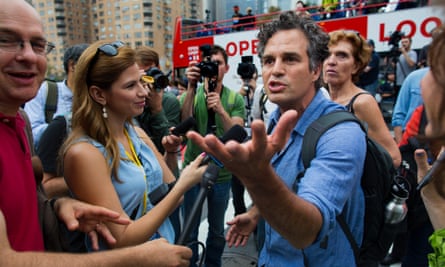
“You can’t get 200 people together and not have something get out of it. It’s going to be huge,” Ruffalo, a prominent supporter of environmental causes, told the Guardian. “I don’t know exactly the effect, but I promise you one, five, 10, 15 leaders are going to come out of it, and do something. Somebody is going to want to be a hero.”
The day started in Melbourne, where demonstrators carried their giant Abbott in protest at his repeal of the carbon price.
This time the usual call-and-response of “What do we want? Climate action. When do we want it? Now” was revised to “10 years ago”, for a crowd that felt it had already fought this battle.
“I’m deeply concerned about my children’s future. They are the ones who will have to clean it up,” Victoria Marshall-Cerins said. “Australia is now dragging its heels. From one of the world’s leaders, we’re now going backwards. We’re embarrassing.”
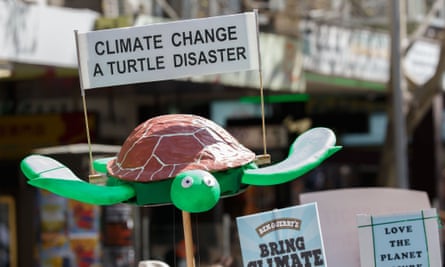
In London, the campaign group Avaaz, which helped organise the event, said 40,000 people attended, although other estimates put the crowd at 27,000. A rally was held outside parliament, which the compere kicked off by asking the crowd: “Who’s sick of the ice receding faster than David Cameron’s hairline?”
The bishop of London, Richard Chartres, gave the first speech. “We are tenants, and we must keep the Earth fit for our children,” he said. “Climate change is a moral issue.”
The actor Emma Thompson also spoke: “Every single person on this Earth has the power to change the world. And when we all come together, our power becomes irresistible. Now we must use our power to tackle the biggest threat humanity has ever faced.”
Earlier, she told the Guardian: “Unless we’re carbon-free by 2030 the world is buggered.”
The designer Vivienne Westwood railed against capitalism in her address: “A triad of [fossil fuel] monopolies, banks and politicians are ruining the planet. If runaway climate change kicks in then within a generation there will be very little habitable on the planet and the suffering will be unimaginable.”
Alice Hooker-Stroud, a scientist from the Centre for Alternative Technology in Wales, used the platform to argue that a zero-carbon Britain was attainable with existing energy technologies. “We have huge renewable energy resources in the UK,” she said. “Business as usual is not a possible future.”
In the crowd, Victoria Bamford, a 66-year old gardener from Wales, had left her home at 6am to reach the capital in time. “We are on a knife edge now in every way,” she said. She had noticed changes in the climate in her work.
“You cannot rely on the seasons any more, and plants are getting stressed and ill,” she said. “I’m no bloody expert, but we have to tackle the fossil fuel business, but I don’t think the government is doing anything.”
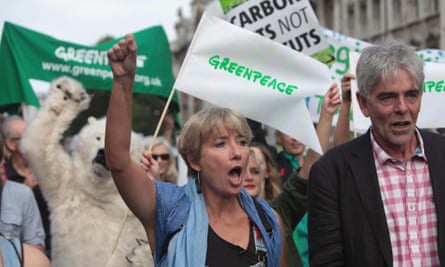
Nearby, 10-year-old Lauren [her mother declined to give her surname] from Oxford, was carrying a colourful homemade banner which declared: “Tick tock climate clock – stop climate change now.”
The gay rights activist Peter Tatchell told the Guardian: “Climate change is a global emergency – governments governments must act soon.”
Ben Phillips, the campaigns director of the charity Oxfam, explained why his organisation took part: “In the past five years alone, that’s since the last time leaders met to discuss climate change, 112,000 lives have been lost, 650 million people have been affected by climate-change related disasters and half a trillion dollars has been lost.”
He said the march was about keeping the pressure up on politicians. “If you ask the suffragettes, the civil rights movement or the India freedom movement just 10 years in, 20 years in, ‘what have you achieved?’, they’d say: ‘Well we’ll keep on fighting until we win’, and so will we.”
Numerous marchers wore costumes, including a polar bear and small herd of gazelles. One of the latter, Merlin from Brighton, said: “People are important, but animals are vital as well. We are here representing all the animals not here today.”
The London march ended with a minute of silent reflection, followed by loud cheers.
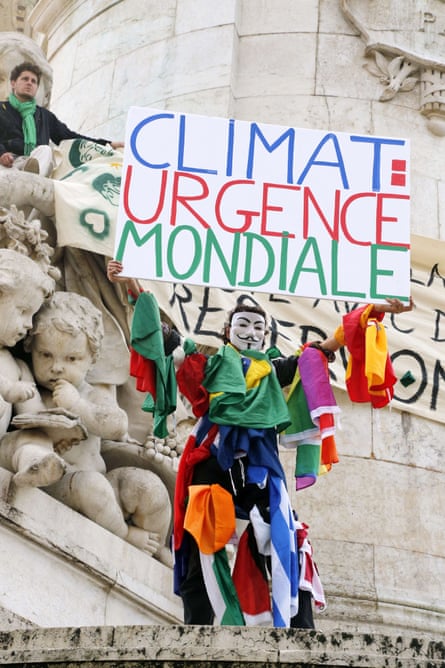
In Paris, organisers said 25,000 people attended – heavy with the knowledge that history would be made on climate, one way or another, in the city in a year’s time. Police put the attendance at 8,000.
An Avaaz campaigner, Pascal Vollenwieder, said the global action was designed to restore the sense of momentum at the beginning of a year-long campaign leading up to the Paris conference.
“This is just the starting point,” he said. “After Copenhagen, we had to show the people that there is still a climate movement.”
Comments (…)
Sign in or create your Guardian account to join the discussion